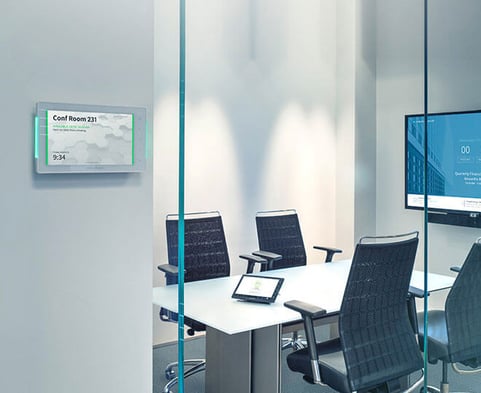Huddle spaces are becoming a standard in modern day work environments. With open office design becoming the norm in Corporate America, it is critical to provide teams an opportunity to work together in smaller, more intimate collaboration spaces.

What is a Huddle Space?
Huddle spaces/rooms are small and private meeting spaces that are designed for smaller teams (think 3-6 people) and have the audio, video, and display system technology needed to power collaboration and efficiency. It can be used for meetings, brainstorming sessions, recaps, or other face-to-face, quick get-togethers.
According to a Frost & Sullivan survey, 50% of organizations have already deployed huddle spaces, while 30% more are planning to incorporate them within the next year - are you one of these businesses?
What are the Benefits to Huddle Spaces?
- Eliminate Distractions. If your office space has an open floor plan, huddle spaces are definitely worth considering. In an enclosed space, you can welcome open discussion without worrying about distracting others. Having access to a smaller space, you don't have to worry about booking that huge conference room that holds twenty people when all you have are three on your team.
- Flexibility/Ease of Use. There is no more need to schedule a room days or weeks in advance. If something unexpected comes up (which often does in the business world), you and your team can react right away. Having more than one huddle space is a good idea because then multiple teams can use them at the same time. No need to reserve a meeting room, you can just pop in, start-up, and go.
- Connect with Anyone, Anytime. Fully equipped with an audio, video, and display system, you have endless possibilities for seamless collaboration. Team members that aren't in the same geographical area can still meet face-to-face through video conferencing, or dial into a team call. If you are on a team with remote members, this keeps everyone connected and on the same page.
- Encourage Collaboration and Efficiency. The huddle room design is considered to be a "collaboration hot-zone" that "supports the kind of business transformation that will define successful companies." These spaces are ideally designed for short, ad-hoc conversations.
- Intimate Communication. Keep everyone involved with close-knit meetings. With little distraction, you can talk about the tasks and topics at hand, contribute your ideas and next steps, and wrap up in little to no time (project depending, of course). Where large company meetings struggle to keep you engaged, huddle spaces and small conference rooms keep people on-task and more attentive.
- Designed for More. Huddle rooms are great for many different things: sales calls, one-on-one's, power hours, webinars, team collaboration sessions, and can even be utilized for individuals when they need somewhere to buckle down with no distractions.
What are the Common Elements of Huddle Spaces?
- Furniture. First and foremost, you need furniture in any space. The room will typically seat 4 to 6 people and have a table for functional purposes. The room will also be equipped with audiovisual technology like a camera and microphone, as the room is designed for collaboration, both in and out of the room.
- A great thing about huddle spaces is that you get to pick the aesthetic - and that doesn't necessarily have to be cohesive to the rest of the office. The limited space allows you to make bold choices and each huddle room can be a different theme.
- The Display. Interactive display boards or simple LED monitors are often the go-to's in this space. This visual technology empowers collaboration with HDMI and Bluetooth capabilities. With seamless sharing, teams no longer have to gather around one laptop. Having a display allows for the presenter to put their presentation or video conference up on the television, allowing for ease of use and driving efficiency.
- A suggestion - because huddle spaces are small, you should stay around 42"-50" for the screen size. Also, when deciding what height to mount the television, it is recommended to stay close to eye level.
- Whiteboards. A touch of traditional is good! The ability to write out ideas and concepts in real-time with an actual marker in hand is sometimes exactly what you need to allow you and your team to get the job done. If you are huddling for a brainstorm session, it is ever more critical.
- A suggestion - take pictures of your whiteboard at the end of each session! While meeting notes are valuable, a picture is worth a thousand words. A benefit to this too is that you can share those photos with all of your members, keeping everyone up-to-date and on the same page with the click of a button.
- Ambiance. You need good acoustics and lighting within the huddle space. With acoustics, it is important to have designated spaces that are free from noise and distractions. Natural lighting may also be an element that needs to be dealt with in huddle spaces.
- Sound insulation and/or sound masking technology reduces ambient noise from the office and empowers the audio-quality in the meeting space. Additionally, sound masking technology helps to keep speech confidentiality in tact, securing any sensitive information inside of the room.
- Natural lighting and direct sunlight can lead to glares and washing out of screens. If there is a light source directly behind a subject, a harsh silhouette can be created. Lighting control needs to be implemented in the spaces with windows.
More elements can be implemented, but above are the most common.
If you/your organization hasn't implemented at least one huddle space, you should consider doing so. Many companies are making the switch -- you should too!
Still have questions or are considering adding a huddle space? Give us a call, and we can talk about it together!
888.84.RONCO | www.ronco.net



